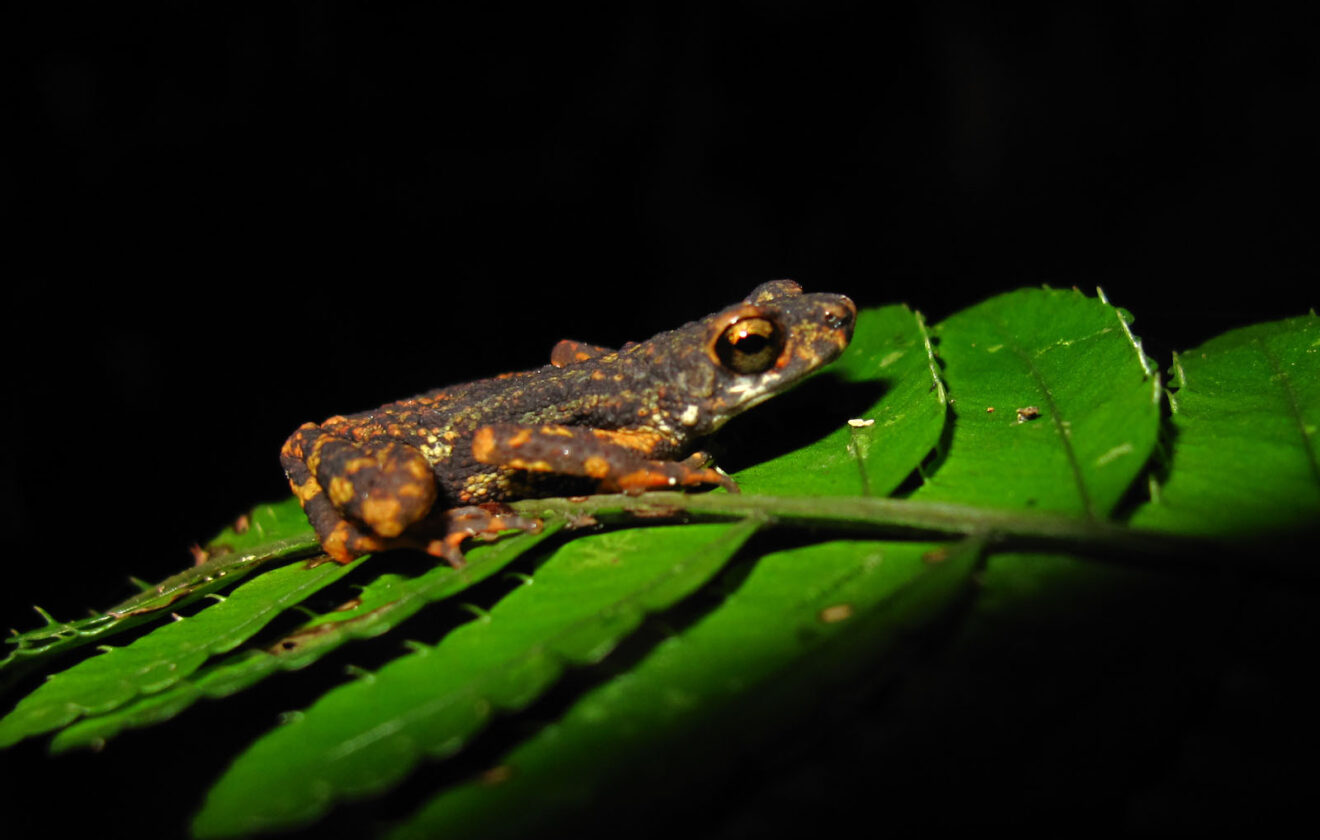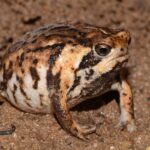Ansonia kraensis: The Enigmatic Stream Toad Hidden within Southeast Asia’s Forests#
Deep within the lush forests of Southeast Asia, a small and elusive amphibian navigates the shaded banks of pristine freshwater streams. Ansonia kraensis, often referred to simply as the Kra Stream Toad, remains unknown even to many amphibian enthusiasts. Yet, this fascinating creature plays a critical role in its fragile ecosystem, offering valuable insights to scientists and captivating the imagination of those fortunate enough to encounter it in the wild.
Belonging to the Bufonidae family, this diminutive amphibian is renowned for its unique adaptations that allow it to thrive within specialized habitats. Despite its importance, Ansonia kraensis frequently slips under the radar of conservation initiatives, underscoring the necessity of broader knowledge and protective measures. But before we delve into the deeper reaches of its world, here is a curious fact to draw you further: unlike many toads known for their terrestrial burrowing behavior, Ansonia kraensis is closely tied to streams, depending wholly on pristine, flowing water for survival.
Taxonomy and Classification#
Ansonia kraensis belongs to the family Bufonidae, commonly known as true toads—a large, diverse group of amphibians spanning nearly global distribution. Within its genus Ansonia, it shares close evolutionary links with other stream-adapted species found predominantly in Southeast Asia’s tropical rainforests. The genus itself is recognized for distinctive morphological and behavioral adaptations uniquely suited to aquatic habitats, setting these amphibians apart from their terrestrial cousins.
Described formally in 2005, Ansonia kraensis is relatively recent to the scientific community. Researchers originally discovered populations on the Kra Isthmus, the slender geographic bridge linking mainland Thailand and the Malay Peninsula, lending the species its distinct name. Ongoing genetic and morphological studies continuously reveal nuanced evolutionary relationships among closely related Ansonia species, particularly those adapting to similar ecological niches across Southeast Asia’s biodiversity-rich terrain.
Natural Habitat#
The habitat of Ansonia kraensis unfolds like a richly woven tapestry of life: dense tropical rainforests that shroud cool, clear streams cascading gently over rocks and pebbles. Endemic to portions of Thailand, particularly the Kra Isthmus region, they represent a specialized ecological niche—a meticulous balance of shaded canopy, flowing freshwater, ample moisture, and a highly oxygenated aquatic environment.
Though many amphibians favor damp terrestrial habitats, Ansonia kraensis exhibits an obligate association with stream ecosystems. Adults and juveniles alike rarely stray far from the soft murmurs of brook water, locally abundant among moist leaf litter, moss-covered rocks, and damp fallen logs at the water’s edge. This specific preference affords unique microhabitat advantages, notably predation avoidance, moisture maintenance critical for delicate amphibian skin, and favorable reproductive conditions.
These rainforest rivers, enriched by seasonal monsoon rains, sustain vibrant communities of aquatic macroinvertebrates—waters teeming with the larvae of insects, mollusks, and other tiny aquatic fauna. Such streams, meandering through shaded canopies and gnarled tree roots, form essential lifelines for the Kra Stream Toad, impacting its health, development, and successful reproduction. Any slight ecological disruption, such as logging or water contamination upstream, poses dire threats to their habitat-dependent existence.
Physical Characteristics#
At first glance, the Ansonia kraensis may not immediately garner attention due to its modest size and cryptic colors. Adults typically measure just around 20–25mm from snout to vent—the perfect miniature adaptors within their microhabitat. Their compact, slender physique and long limbs equip them spectacularly for navigating slippery, moss-covered rocks at stream edges. A closer look, however, reveals a remarkable beauty—as subtle as the rainforest they call home.
Ansonia’s skin is diverging from many terrestrial toads, smoother yet finely granulated and textured, adaptive for minimizing water loss and maximizing respiration efficiency. The coloration consists of intricate earth-toned patterns—shades ranging from muted olive and brown to gentle greyish tones interspersed with lighter markings—seamlessly blending into variegated backgrounds of fallen leaves and muddy banks.
These cryptic tones serve a critical protective function as well, rendering them practically invisible to predators. Despite lacking the flamboyant skin toxins exhibited by prominently colorful frogs, Ansonia species tend to possess mild skin secretions, offering protection and deterring predation while maneuvering open habitat exposures.
Behavior and Life Cycle#
Capturing a glimpse into the world of the Kra Stream Toad reveals a lifestyle intricately bound to the rhythms of its aquatic habitat. Primarily nocturnal, the toads actively forage and mate under the sustained cover of darkness. During daylight hours, they favor secluded refuges beneath rocks, logs, and dense layers of moist leaf litter, patiently awaiting nightfall’s protective embrace.
Feeding Habits#
The dietary selection of Ansonia kraensis reflects the streamside richness of its habitat. These amphibians skillfully employ sit-and-wait tactics, capturing small invertebrates such as ants, termites, beetles, and occasional spiders. Agile leaps paired with rapidly flickering tongues ensure prey has little chance to escape. Amphibians like Ansonia play a critical ecological role in invertebrate population dynamics, regulating communities and helping maintain ecological equilibrium in habitats teeming with insect life.
Breeding and Reproduction#
Marked by the onset of the rainy season, the reproductive cycle of Ansonia kraensis emerges as an enchanting natural spectacle. Confined closely to freshwater streams, these amphibians initiate breeding behavior generally following monsoon rains, when swollen waterways provide suitable nursery conditions. Males congregate along stream edges, emitting soft, melodious calls—a quiet symphony that resonates gently through their evening forested homes—to attract potential mates.
Following a successful courtship, females deposit elongated strands of delicate eggs in small aquatic pools or along gentle stream banks, sheltered between rocks and vegetation. Females and males typically exhibit minimal parental care, relying instead on favorable environmental conditions crucial for successful offspring emergence.
Subsequent larvae (tadpoles) exhibit dramatically adapted morphology suited for rapid growth in dynamic stream conditions. Specialized mouthparts help these aquatic juveniles cling tenaciously to substrates amidst strong flow, harvesting microscopic algae and biofilm. Upon completing metamorphosis, young toads promptly adopt semi-terrestrial lifestyles, eagerly taking residence near parent stream habitats.
Ecological Role#
Ansonia kraensis serves as both predator and prey, assuming a small yet pivotal ecological niche. As a significant consumer of insect populations, this frog is crucial in regulating potentially pestilent invertebrate populations, thereby aiding the preservation and equilibrium of forest biodiversity.
Serving also as vital bioindicators, sensitive amphibians like Ansonia inform scientists of emerging ecological threats. Given their permeable skin and intimate association with water, changes within their habitat—such as chemical pollution, climate shifts, or altered flow regimes—become rapidly evident through declining population numbers and deteriorating health.
This species is also prey to larger vertebrates like snakes, birds, and even larger amphibians, intricately woven into the complex food web of Thailand’s vibrant forests.
Threats and Conservation Status#
The isolated range and specialized habitat needs of Ansonia kraensis position it as particularly vulnerable to anthropogenic stressors. Principle threats include habitat loss and fragmentation due to deforestation, agricultural expansion, and hydrological disruption resulting from poorly managed land-use practices. Furthermore, pesticide residues, chemical runoff, and climate-related events pose pressing threats.
Currently, the International Union for Conservation of Nature (IUCN) lists Ansonia kraensis as Data Deficient, underscoring a critical need for further research into the species’ population trends, ecology, and threats. Improved understanding and targeted conservation measures, such as establishing protected areas around critical habitats and promoting sustainable land management practices, stand imperative for this unique amphibian.
Cultural and Scientific Significance#
While relatively unknown culturally beyond scientific circles, Ansonia species, including Ansonia kraensis, are indispensable ambassadors of ecological health. Their sensitivity and specialized requirements offer researchers crucial insights into sustainable watershed management, aquatic biodiversity conservation, and broader environmental stewardship strategies.
From a scientific perspective, stream-adapted amphibians open doors to deeper understanding of evolution, ecology, and conservation biology. Research undertaken on Ansonia populations informs habitat restoration projects, ecological education programs, and bioindicator research that benefit entire ecosystems and human communities sharing these vital forest resources.
Conclusion#
Hidden within the tranquility of Southeast Asia’s pristine streams, the Ansonia kraensis exemplifies the quiet yet critical roles amphibians fulfill in their ecosystems. Understanding, protecting, and preserving such species illuminates broader ecological connections and sustains biodiversity itself. Your awareness and support are essential. By expanding knowledge and fostering genuine appreciation, we champion not just a single beautiful creature, but the wondrous, interconnected world we all share. Explore, learn, protect—Ansonia kraensis and its world are counting on us.








